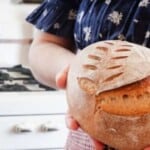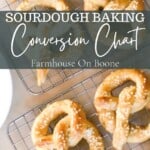Baking doesn’t have to be complicated or challenging. Here is a simple baking conversion chart to help make sourdough baking more straightforward.

Table of Contents
I have a true love for sourdough, which is not really a surprise at this point. My love and knowledge for this type of baking has grown a lot over the years.
Recipes continue to change, and get better, all in order to get more fermented grains into others homes.
If you are new to sourdough, you can look through over a hundred recipes available on this site, and you can even learn how to transform your favorite recipes into sourdough ones.
While many people use cups to bake with, others use a scale, so I wanted a place to be able to share measurements for both ways to make it more exact and accommodating.

Measuring Flour
- I’m not a technical baker. The “appropriate” way to measure flour is to fluff it up, spoon it into a dry measuring cup and then use a knife of straight edge to level it off. That is just too much fuss for me. I’m more of a dunk my measuring cup into my large canister of flour and shaking it level kind of person.
- If you research flour weights and measurements, you will find slightly differing amounts. These measurements will work for any recipes on this website.
This post contains affiliate links, which means I make a small commission at no extra cost to you. See my full disclosure here.

Benefits Of Using A Kitchen Scale:
- Many people love using a kitchen scale for baking because it can make baking much easier.
- More exact way of measuring.
- It becomes much easier when measuring small amounts of ingredients.
- Better and more consistent results.
- Measure everything in one bowl. You don’t need separate measuring cups, spoons, and liquid measuring cups.

Helpful Baking Tools
Cast iron dutch oven (for artisan loaves and boules)
Baking dishes and cast iron skillets
Sourdough Baking Conversion Chart
Please note that this chart is for converting Farmhouse on Boone recipes, where the recipe is demonstrated in cup measurements. The reason this distinction has to be made is because there are different ways to measure a cup of flour that cause a wide variation in the ending weight.
When using the spoon and level method, one cup of flour ends up weighing 120 grams. Notice the discrepancy in my measurements, where one cup of flour weighs 140 grams. This is because of my no-fuss baking approach, which involves dunking the measuring cup straight into the flour and leveling it off of the top.
I repeated my “super scientific” method of dunking the cup into the flour, leveling it off and pouring it into a bowl, then times. On average I came up with 140 grams.
I had my recipe tester, who lives across the country, repeat this same process in her own home, and she also came up with 140 grams.
So, Though the internet mostly says one cup of all purpose flour weighs 120 grams, my recipes are tested with the one cup = 140 grams measurements. This also applies to bread flour, which generally weighs the same as all purpose flour.
I’m trying to save you some time in the kitchen, and who has time to fill a cup measurer with flour spoon by spoon? I can’t be the only baker who finds this unnecessarily tedious!
I noticed through lots of testing that 100% whole wheat flour actually weighs a bit more than all purpose. Also, milk weighs more than water.
You may notice in the chart, the significant weight difference between active starter and sourdough starter discard. This is because when a starter is bubbly, active and at its peak, it is light and fluffy. When the yeasts are past the active stage, the starter sinks down and becomes a bit more dense.
I know this all drives very precise bakers insane, but I can assure you that I have baked everything from bread to bagels, cookies and muffins, and everything in between at all different stages of starter activity, and it has all turned out just fine.
This is supposed to be fun and nourishing, my friends. Let’s not overcomplicate it too much!

















Please help. I have an older model bread machine that does Not have a knead function only.
My functions are Basic, Basic Rapid, Whole Wheat, Whole Wheat Rapid, French, Sweet, and Dough functions. My machine still works beautifully, so I don’t want a new one.
However, I’m trying to make sourdough bread (❤️) with Azure Standard alive and bubbly sourdough starter in my machine. Question is, would I set to Dough function, which is, 1:20 and then, let rise for 4-6 hours and then, what? Bake function will knead and rise 3 more times?
I’ve tried a few loaves and my last one did good, but didn’t rise fully to 1.5 loaf size. I’m determined to get a nice, consistent load! Thank you! Eden
Hey Lisa! I just purchased your Daily Sourdough book and I’m loving it- best loaves I’ve ever attempted!! My question is regarding feeding the starter. Your book mentions feeding one cup of starter with 1/2 cup water and 1/2 cup flour, but also says use a 1:1:1 ratio. Wouldn’t this make it a 2:1:1 ratio? Should I only be using 1/2 cup of starter for feeding? Would love some clarification bc my starter is 3 weeks old now and still taking foreverrrrrr to double when I feed it. Thanks!
I’m new to sourdough and have been enjoying it so far.
How do you make 1 1/2 cups active starter for a recipe? Recipes will say you need xx cups or xx g of active starter but not tell you how to make that amount of starter for the recipe.
Usually when I feed my starter the night before I do approximately 1/4 cup starter, 1/2 cup water and 1/2 cup flour and that makes enough starter for any recipe I’ve ever used.
I’ve been using your easy beginner recipe for sourdough for months and it’s been great! However the last few times, the dough has been sticking to the bowl after the first rise. I have starting using a scale instead of measuring cups, so I’m wondering if the dough is more wet? The bread still turns out ok, but I feel like I’m losing a lot of bubbles when getting it out of the bowl. I’m using stainless steel bowls and this didn’t use to happen. Help! Thanks. 🙂
The dough could be more wet! Are you oiling the bowl before putting it in there? You could always oil it and then add some flour down as well. That helps!
I had thought about trying oil. I’ll give that a shot. Thanks! PS: love your site and recipes!
Hi there! Will this conversion chart work for Jovial AP einkorn flour, as well? I would love to use less measuring cups while baking/cooking.
It might need adjusted a bit! You may have to add more flour because einkorn is a heavier flour than AP.